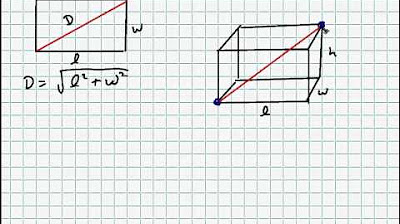What Is Pythagoras Theorem? | PYTHAGORAS THEOREM | The Dr Binocs Show | Peekaboo Kidz
Summary
TLDRThis video script explores the Pythagorean theorem, a fundamental principle in geometry with real-world applications. It traces the theorem's history, noting its use in ancient civilizations like Babylon and India, predating Pythagoras. The script explains the theorem's statement—that in a right-angled triangle, the square of the hypotenuse equals the sum of the squares of the other two sides—and illustrates it with a practical example involving a cat rescue scenario. It demonstrates how to apply the theorem to find the correct ladder length, emphasizing the theorem's relevance and utility in everyday situations.
Takeaways
- 📚 The Pythagorean theorem is named after Pythagoras of Samos, a Greek mathematician and philosopher, but he was not the actual founder of the theorem.
- 🌟 The theorem predates Pythagoras and was used by ancient Babylonians and Indians, as well as in Egyptian constructions.
- 📐 The theorem states that in a right-angled triangle, the square of the length of the hypotenuse (the side opposite the right angle) is equal to the sum of the squares of the lengths of the other two sides.
- 🔢 The Pythagorean equation is expressed as \( a^2 + b^2 = c^2 \), where \( a \) and \( b \) are the legs of the triangle, and \( c \) is the hypotenuse.
- 📏 The theorem can be applied to real-world problems, such as determining the length of a ladder needed to reach a cat stuck on a wall.
- 🐱 An example in the script illustrates using the theorem to find the correct ladder size by measuring the lengths of the wall and the ground, and then calculating the hypotenuse.
- 🧮 To find the ladder's length, one must square the measurements of the wall and the ground, add them together, and then take the square root of the result to get the length of the hypotenuse in meters.
- 🛠️ The script demonstrates how to apply the theorem step by step, including the calculation of squares and the use of the square root to find the practical solution.
- 📈 The script also touches on the historical and cultural significance of the theorem, mentioning the Pythagorean society and their contributions to science and philosophy.
- 🌱 The Pythagoreans believed in the equal rights of animals, which led to their prohibition of eating animals, showing a connection between their mathematical pursuits and ethical beliefs.
- 🎓 The episode concludes with an invitation to learn more in future episodes, emphasizing the educational purpose of the content.
Q & A
Who is the Pythagorean Theorem named after?
-The Pythagorean Theorem is named after the Greek mathematician and philosopher Pythagoras of Samos.
Did Pythagoras invent the Pythagorean Theorem?
-No, Pythagoras did not invent the Pythagorean Theorem. He is credited with proving it, but the theorem existed even before him.
In which ancient civilizations was the Pythagorean Theorem used?
-The Pythagorean Theorem was used in ancient Babylon, India, and Egypt.
What does the Pythagorean Theorem state?
-The Pythagorean Theorem states that the square on the hypotenuse of a right-angled triangle is equal in area to the sum of the squares of the other two sides.
How is the Pythagorean Theorem expressed mathematically?
-The Pythagorean Theorem is expressed as a^2 + b^2 = c^2, where a and b are the legs of the triangle and c is the hypotenuse.
What are the legs and hypotenuse of a right-angled triangle?
-In a right-angled triangle, the legs are the two sides that form the right angle, and the hypotenuse is the side opposite the right angle and the longest side of the triangle.
How can the Pythagorean Theorem be applied in a real-life scenario?
-The Pythagorean Theorem can be used to determine the length of a ladder needed to reach a certain height on a wall when the distance from the wall to the base of the ladder is known.
How do you calculate the hypotenuse using the Pythagorean Theorem?
-To calculate the hypotenuse c, you take the square root of the sum of the squares of the other two sides, c = sqrt(a^2 + b^2).
What was the length of the wall and the land in the provided example?
-In the provided example, the length of the wall was 3 meters, and the length of the land was 4 meters.
What is the significance of the Pythagorean Theorem in construction?
-The Pythagorean Theorem is significant in construction as it helps in determining accurate measurements and ensuring structures are built correctly, such as in the construction of the pyramids in ancient Egypt.
What values did the example provide for a^2 and b^2?
-In the example, a = 3 meters and b = 4 meters. Therefore, a^2 = 9 and b^2 = 16.
What is the final step to find the length of the hypotenuse in the example?
-The final step is to take the square root of c^2, which in the example is sqrt(25) = 5 meters.
Outlines

This section is available to paid users only. Please upgrade to access this part.
Upgrade NowMindmap

This section is available to paid users only. Please upgrade to access this part.
Upgrade NowKeywords

This section is available to paid users only. Please upgrade to access this part.
Upgrade NowHighlights

This section is available to paid users only. Please upgrade to access this part.
Upgrade NowTranscripts

This section is available to paid users only. Please upgrade to access this part.
Upgrade NowBrowse More Related Video
5.0 / 5 (0 votes)





